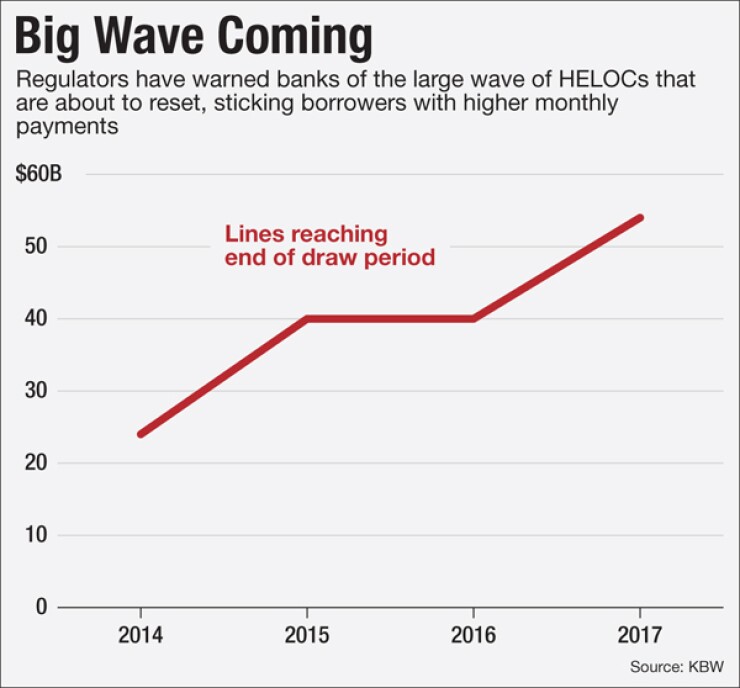-
Programs to help underwater borrowers with second liens are languishing and the Treasury's authority to create and fund new ones under the Troubled Asset Relief Program expired several years ago.
April 4 -
A new report from Moody's suggests that roughly a dozen regional banks are at risk of sustaining meaningful credit losses on home equity lines of credit that were originated in the boom years and are scheduled to reset over the next three years.
January 21 -
FinTech Innovation Lab in New York bites its thumb at Silicon Valley; Dan McCardell, formerly of the Bush White House, joined The Clearing House; Cynthia Williams, EVP and Chief communications officer at BB&T, takes on corporate branding; Carlos Loumiet, formerly of Hamilton Bank, entitled to recover legal fees from the OCC; Robert Bostrom leaves Freddie Mac for SNR Denton; Jack Kopinsky on his way to Provident Bank in New York;.
September 1


Banks have generally heeded regulators' warnings to reduce exposure to home equity lines of credit, ahead of a
But they're not out of the woods yet.
Many banks, especially midsize and regional ones, still hold elevated levels of HELOCs and a significant portion is made up of loans originated between 2004 and 2007. The risk is that, when the loans switch from interest-only to fully amortizing, some borrowers won't be able to afford the higher monthly payments, creating a spike in nonperforming loans and chargeoffs.
The total value of home equity lines at their end of draw periods is expected to rise from $24 billion in 2014 to $54 billion in 2017, according to the Office of the Comptroller of the Currency. The OCC and other regulators have been
"A lot of these customers never intended for their HELOCs to reach the end of the draw period," said Bob Piepergerdes, acting deputy comptroller for credit risk at the Office of the Comptroller of the Currency. "Quite honestly, a lot of customers don't even realize when their loans are to be reaching the end of the draw period."
Three banks in particular show signs of the potentially greater risk, KBW analysts note in a Jan. 13 report. Each of these institutions the $345 billion-asset PNC Financial Services Group in Pittsburgh; the $23 billion-asset Webster Financial in Waterbury, Conn.; and the $2.8 billion-asset TriCo Bancshares in Chico, Calif.-holds a portfolio of home equity lines with characteristics that could lead to more problem loans.
All three banks have a HELOC portfolio that equals at least 10% of total loans; at least 28% of each of their portfolios was originated between 2004 and 2007; and their credit lines exceed KBW's industry average for both 30-89 days past due and for nonaccruals.
Representatives from PNC and Webster defended their companies' risk management and said they have the situation under control.
"We contact borrowers 6 to 9 months in advance of their end of draw period and we contact them multiple times and in multiple channels," said Marcey Zwiebel, a PNC spokeswoman. PNC also "discuss[es] [customers'] options for adjusting their payment or terms in ways that are mutually agreeable."
"Webster has a strong, proactive line management program to help customers whose lines are maturing within a year," said Sarah Barr, a Webster spokeswoman.
"More than two-thirds of Webster's portfolio was originated after 2007, has high credit scores and low loan-to-value ratios, and will reach maturity after 2017," Barr said. "Our experience to date has not been a cause for concern. Our processes for underwriting and servicing the loans has been reviewed by regulators and deemed appropriate."
Richard Smith, president and chief executive of TriCo Bancshares, did not return a call seeking comment.
Other industry watchers, including Ezra Becker, vice president of research and consulting at credit bureau TransUnion, have said the
A number of banks have reduced their exposure by letting home equity lines run off their books and replacing them with other types of credits, KBW also said.
Still, there are more banks besides PNC, Webster and TriCo that are at risk for a spike in nonperforming home equity lines, based on other measurements, KBW said in its report. For example, increases in HELOC utilization rates of 50 basis points or more since 2012 would be a red flag for banks whose home equity lines make up 7% or more of total loans.
Banks falling in this category include the $2.2 trillion-asset JPMorgan Chase in New York; the $25 billion-asset FirstMerit in Akron, Ohio; the $19 billion-asset TCF Financial in Minneapolis; and the $26 billion-asset First Horizon National in Memphis, Tenn.
During First Horizon's third-quarter earnings conference call on Oct. 17, analysts asked about the bank's home equity lines.
"What are efforts you can look at in selling parts of your HELOC portfolio given there are quite a bit of payment shocks that are
occurring over the next couple of years?" asked Kevin Barker, an analyst at Compass Point Research & Trading.
"We've got a lot of experience of managing the transition from the revolving period to the payment period, and we've had reasonably good success in terms of our proactive efforts," said Bryan Jordan, First Horizon's chairman and chief executive. "We don't see the transition from revolving to payment to be a huge issue."





